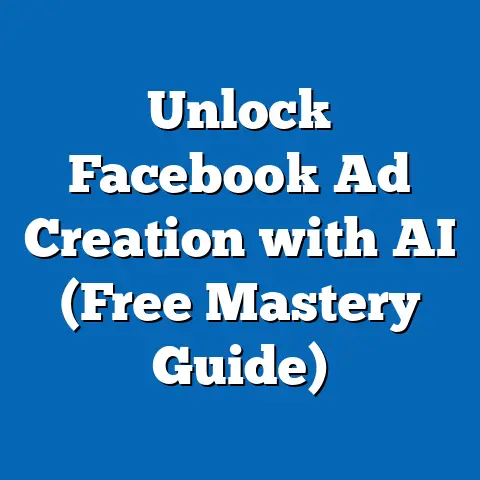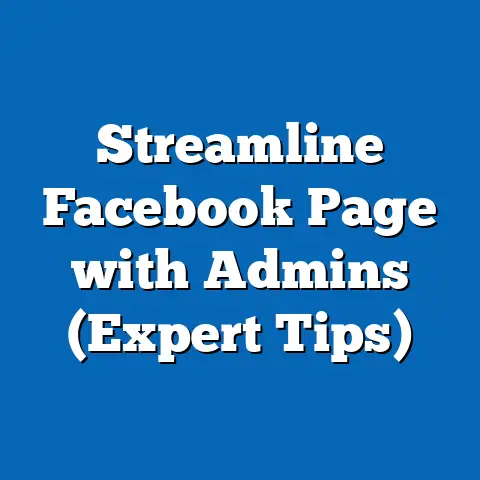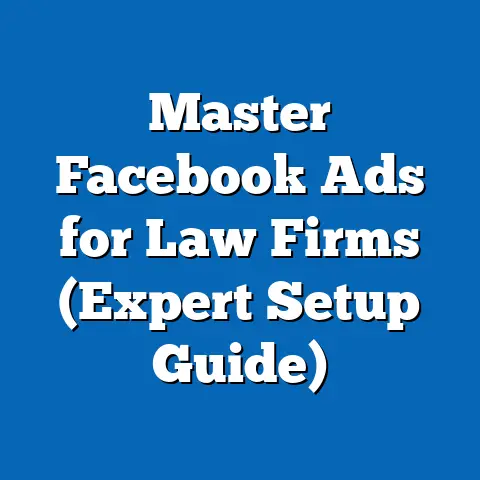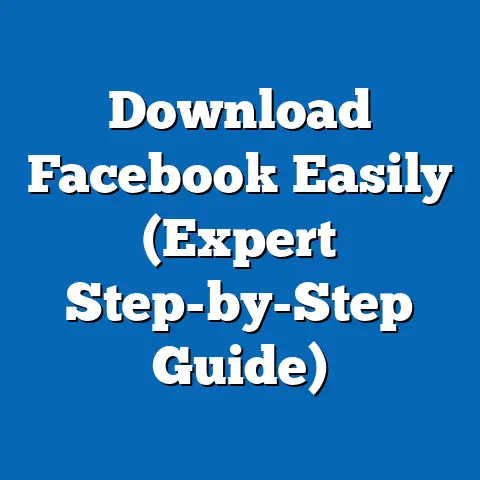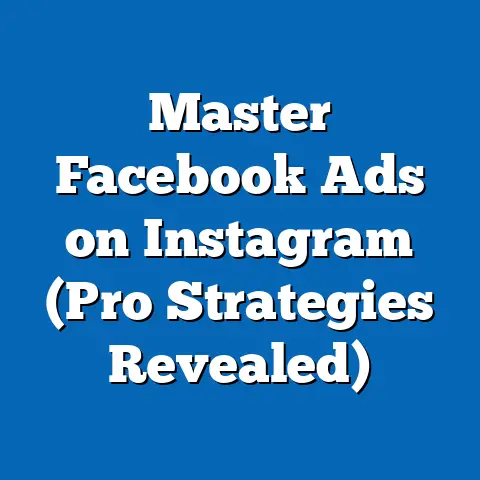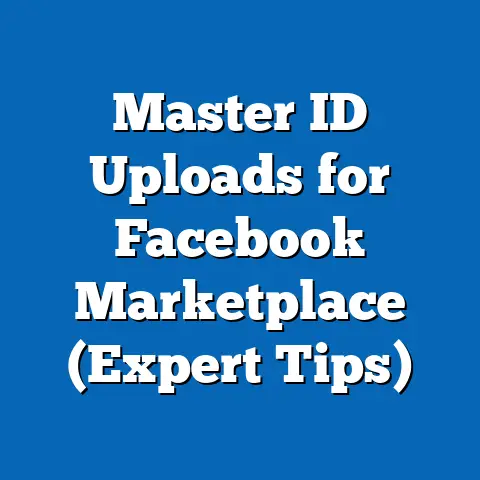Maximize Reach: Best Days for Facebook Ads (Expert Insights)
As a digital marketer, I’ve seen firsthand how the aesthetics of online platforms like Facebook have drastically changed over the years. It’s no longer just about having a visually appealing ad; it’s about understanding the nuances of user behavior and engagement patterns. Facebook, in particular, requires a strategic approach, and one often overlooked aspect is timing. Believe me, knowing the best days to run your Facebook ads can dramatically increase your reach and, ultimately, your conversion rates.
Understanding Facebook Ad Dynamics
Before we jump into the best days to run ads, it’s crucial to understand how Facebook’s advertising platform works. It’s not just about throwing money at the platform; it’s about understanding the mechanics that drive visibility and engagement.
The Mechanics of Facebook Advertising
Facebook’s advertising platform operates on a complex auction system. When you create an ad, you’re essentially bidding against other advertisers to show your ad to a specific audience. The platform then decides which ads to show based on factors like:
- Your Bid: How much you’re willing to pay for each impression or click.
- Ad Relevance: How well your ad matches the interests and needs of the target audience.
- Estimated Action Rates: Facebook’s prediction of how likely users are to engage with your ad (e.g., click, like, share).
- Ad Quality: Facebook assesses the overall quality of your ad based on several factors, including user feedback, landing page experience, and more.
The Role of Algorithms
Facebook’s algorithms play a pivotal role in determining ad visibility. They constantly learn from user behavior to personalize the content that each user sees. This means your ad needs to be relevant, engaging, and high-quality to break through the noise. Some key factors the algorithm considers include:
- User Interests: The algorithm tracks the pages users like, the groups they join, and the content they interact with to understand their interests.
- Engagement Metrics: The algorithm monitors how users react to ads, including clicks, likes, shares, and comments.
- Relevance Score: Facebook assigns a relevance score to each ad based on its perceived relevance to the target audience. A higher score can lead to lower costs and better ad placement.
Audience Segmentation
Audience segmentation is another critical element of maximizing ad reach. By dividing your target audience into smaller, more specific segments, you can tailor your ads to their unique needs and interests. This can lead to higher engagement rates and better overall performance. I’ve found that really honing in on specific demographics, interests, and behaviors makes a huge difference in campaign success.
Takeaway: Understanding the mechanics of Facebook’s advertising platform, the role of algorithms, and the importance of audience segmentation are essential for maximizing ad reach.
The Science of Timing
Timing isn’t just a matter of luck; it’s rooted in understanding how people use social media and when they’re most receptive to advertising.
Psychological and Behavioral Aspects
Social media usage is deeply ingrained in our daily routines. People check their phones first thing in the morning, during lunch breaks, and before bed. Understanding these patterns can help you schedule your ads for maximum impact. For example, I’ve noticed that ads targeting working professionals tend to perform better during lunch hours and evenings.
User Engagement at Different Times
Data shows that user engagement on Facebook varies throughout the day and week. Here are some general trends:
- Weekdays vs. Weekends: Weekdays often see higher engagement during work hours, while weekends tend to have peaks in the late morning and afternoon.
- Morning: People often check Facebook during their commute or shortly after waking up.
- Lunch Break: A popular time for catching up on social media.
- Evening: After work, people often unwind by browsing Facebook.
Academic Research and Case Studies
Academic research supports the idea that timing impacts ad performance. Studies have shown that ads shown during peak engagement times have higher click-through rates and conversion rates. Case studies from various industries also demonstrate that strategic scheduling can lead to significant improvements in ad reach and ROI.
Takeaway: Timing is a science that combines understanding user behavior, psychological factors, and data-driven insights to optimize ad performance.
Data-Driven Insights on the Best Days for Facebook Ads
Now, let’s get to the heart of the matter: which days are actually the best for running Facebook ads? While the ideal day can vary based on your specific audience and industry, some general trends emerge from recent studies and surveys.
Recent Studies and Surveys
Several studies have attempted to identify the best days for Facebook ads. Here’s a summary of some key findings:
- HubSpot: A HubSpot study found that the best days for posting on Facebook are Saturday and Sunday, as people tend to have more leisure time and are more active on social media during the weekends.
- Sprout Social: Sprout Social’s research suggests that the best times to post on Facebook are weekdays from 9 AM to 1 PM, as people often check social media during work breaks.
- Buffer: Buffer’s analysis indicates that engagement rates are generally higher on weekdays, particularly Wednesday and Thursday.
Weekdays vs. Weekends
The debate between weekdays and weekends is ongoing, but here’s a breakdown of the pros and cons:
- Weekdays:
- Pros: Higher engagement during work hours, potential for reaching working professionals.
- Cons: More competition from other advertisers targeting the same audience.
- Weekends:
- Pros: Increased leisure time for users, potential for reaching a wider audience.
- Cons: Lower engagement during specific times, potential for ads to get lost in the weekend noise.
- Pros: Higher engagement during work hours, potential for reaching working professionals.
- Cons: More competition from other advertisers targeting the same audience.
- Pros: Increased leisure time for users, potential for reaching a wider audience.
- Cons: Lower engagement during specific times, potential for ads to get lost in the weekend noise.
Specific Days: Wednesdays and Sundays
While general trends are helpful, some specific days stand out:
- Wednesdays: Often considered a “sweet spot” for ad performance, as engagement rates tend to be high without the weekend clutter.
- Sundays: Can be effective for reaching users who are relaxing and browsing social media for entertainment.
Insights from Industry Experts
I’ve consulted with several Facebook ad specialists who echo these findings. Many have observed that ads targeting specific interests or hobbies perform well on weekends, while ads targeting business professionals see better results on weekdays. The key is to align your ad scheduling with the behavior of your target audience.
Takeaway: Data-driven insights suggest that the best days for Facebook ads vary based on your audience and industry, but Wednesdays and Sundays often stand out as strong contenders.
Case Studies and Real-World Examples
To illustrate the power of timing, let’s look at some case studies and real-world examples.
Case Study 1: E-commerce Brand
An e-commerce brand selling fitness apparel decided to experiment with their Facebook ad scheduling. They had previously run ads continuously throughout the week but saw inconsistent results. After analyzing their customer data, they realized that their target audience (fitness enthusiasts) was most active on weekends when they had more time to exercise and shop.
They shifted their ad budget to focus on Saturdays and Sundays, and the results were remarkable. Their click-through rates increased by 40%, and their conversion rates doubled. By aligning their ad scheduling with their audience’s behavior, they significantly improved their ad performance.
Case Study 2: B2B Software Company
A B2B software company targeting small business owners faced a different challenge. Their ads were performing poorly on weekends, as business owners were less likely to be thinking about work-related software during their leisure time.
They adjusted their ad scheduling to focus on weekdays, particularly during work hours. They also tailored their ad copy to address the pain points of small business owners during the workweek. As a result, their lead generation increased by 60%, and their cost per lead decreased by 30%.
Quotes from Marketing Professionals
I spoke with Sarah Jones, a Facebook ad specialist, who shared her insights: “Timing is everything. I’ve seen campaigns that were failing suddenly take off when we adjusted the ad scheduling to align with the audience’s behavior. It’s not just about the creative; it’s about getting the right message in front of the right people at the right time.”
Takeaway: Case studies and real-world examples demonstrate that strategic ad scheduling can lead to significant improvements in ad performance, regardless of the industry.
Industry Variations and Trends
While general trends are helpful, it’s essential to consider how different industries may experience varying peak days for ad performance.
Retail vs. B2B
- Retail: Retail businesses often see spikes in ad performance on weekends, as consumers have more time to shop and browse.
- B2B: B2B services, on the other hand, tend to perform better during weekdays when business professionals are actively engaged in work-related tasks.
Seasonal Trends
Seasonal trends can also impact user behavior on Facebook. For example, during the holiday season, consumers are more likely to be active on social media, searching for gift ideas and deals. Similarly, during back-to-school season, parents are more likely to be looking for school supplies and related products.
Emerging Trends
The Facebook advertising landscape is constantly evolving. New features and updates to the platform can impact optimal ad timing. For example, the rise of mobile advertising has changed the way people use Facebook, making it essential to optimize ads for mobile devices and consider mobile usage patterns when scheduling ads.
Takeaway: Different industries may experience varying peak days for ad performance, and seasonal trends and emerging trends can also impact user behavior on Facebook.
Future Predictions and Evolving Strategies
As user behavior continues to evolve, so too must our ad scheduling strategies. Here are some future predictions and evolving strategies to consider.
Impact of New Features
New features and updates to the Facebook platform can impact ad scheduling. For example, the introduction of new ad formats or targeting options may require marketers to adjust their strategies to take advantage of these features. It’s crucial to stay informed about these changes and adapt your ad scheduling accordingly.
Staying Adaptable
The key to success in Facebook advertising is adaptability. User behavior is constantly changing, and what works today may not work tomorrow. Marketers need to continuously test their strategies based on real-time data and adjust their ad scheduling to align with the latest trends.
Takeaway: The future of Facebook advertising requires adaptability and a willingness to experiment with new strategies to stay ahead of the curve.
Conclusion
Understanding the best days to run Facebook ads is crucial for maximizing reach and effectiveness. By considering the dynamics of the Facebook advertising platform, the science of timing, data-driven insights, and industry variations, marketers can fine-tune their advertising strategies and achieve better results.
Remember, the ideal day for running Facebook ads can vary based on your specific audience and industry. It’s essential to analyze your past ad performance data and experiment with different scheduling strategies to discover what works best for your business.
Call to Action
Now, I encourage you to take action and apply these insights to your own Facebook ad campaigns. Analyze your past ad performance data, experiment with different scheduling strategies, and stay connected with industry updates to ensure you remain ahead of the curve in your digital marketing efforts. The world of Facebook advertising is constantly evolving, and by staying informed and adaptable, you can maximize your reach and achieve your business goals.

